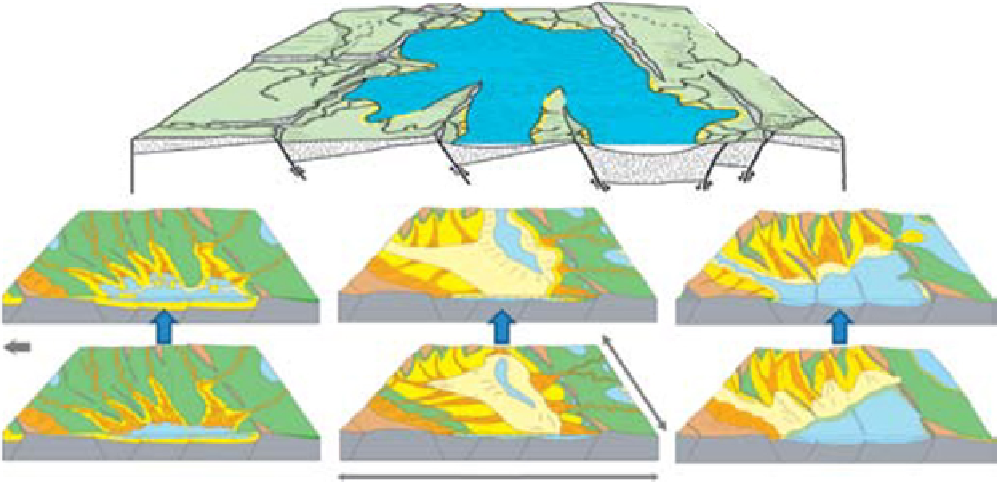Geoscience Reference
In-Depth Information
Rift-marginal or interior drainage
Syn-rift drainage
rift-marginal and
interior
major incision and
river capture
Antecedent axial
(backstepping)
Consequent-Juvenile
hanging-wall
Major sediment entry
point at cross-
cutting fault
A
nt
e
cedent
tr
ansverse
transfer
zone
Rift-Interior or drainage
Consequent-Juvenile
fault-scarp & hanging-wall
Antecedent transverse
(major incision)
Consequent
Reversed
Large footwall-sourced
system (antecedent
or consequent)
Redirected
(axially)
N
150km
Tilje aggradational to
retrogradational segment
(Tofte-)Ile aggradational to
retrogradational segment
Garn aggradational to
retrogradational segment
Fig. 14.
Conceptualised Gross Depositional Environments (GDEs) for the transgressive segments of the Halten Terrace
Lower and Middle Jurassic megasequences. Note the inherent contrasts in GDEs for the Tilje, Tofte, ile and Garn megase-
quences, despite overall gross similar sequence development. Note the large variability in component depositional systems
for the various megasequences, caused by mainly differences in basin structuring, sediment supply and calibre and basin
physiographies. The same colour representations have been used as in Fig. 13.
dominated. in other units, such as in the Tofte-ile
megasequence, there was a dominance of tide-
influenced to tide-dominated river deltas and
estuaries, sourced by candidate braided fluvial
systems.
in combination, this suggests increased rates of
structuring and topographic rejuvenation, of both
the wider basin areas, individual sub-basins and
bordering highs during deposition of the transgres-
sive segments (Fig. 12C). This is typical of basins
subject to mild rifting (see Ravnås & Steel, 1998;
Ravnås
et al
., 2000). The presence and thickness of
Triassic salt influenced the resultant structural
styles strongly, as evidenced by local synclinal
sub-basins as well as shorter wave-length fault-
blocks/half-grabens and localised horst-and-
graben structures (e.g. Pascoe
et al
., 1999; Corfield
& Sharp, 2000; Corfield
et al
., 2001; Marsh
et al
.,
2010). These lateral changes in style of structuring
and thereby rift topography, resulted in rapid to
more gradual lateral variations from depositional
sinks to bordering highs in terms of topography
and basin physiography (Fig. 14). This is reflected
in differences and contrasting developments of
the transgressive segments between sub-basins in
terms of their contained facies tract development
and partitioning, depositional (sub-)systems, infill
style and stratigraphic architectures.
Megasequence structure
The megasequences, with a lower progradational
and an upper aggradational to retrogradational part,
can all be divided into systems tracts, including a
basal highstand normal regressive systems tract, a
falling stage, forced regressive to late lowstand nor-
mal regressive systems tract, an aggradational or
early transgressive systems tract and a retrograda-
tional or late transgressive systems tract. These can
be identified purely on stratal stacking patterns
(e.g. see Catuneanu
et al
., 2009) or via inferred
shoreline trajectory patterns (e.g. Helland-Hansen
& Gjelberg, 1994; Helland-Hansen & Hamspon,
2009) inferred from well (and core) data.
The megasequences are defined as second order
genetic sequences (Galloway, 1989) with the full
series of systems tracts (Brown & Fisher, 1977; Van
Wagoner
et al
., 1988, 1990; Posamentier
et al
., 1988;
Posamentier & Allen, 1999). Their component
systems tracts define higher-order (candidate third


Search WWH ::

Custom Search